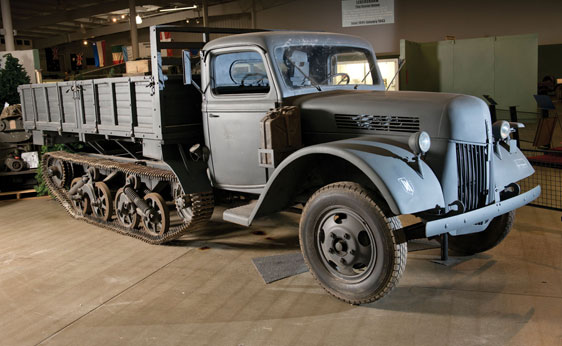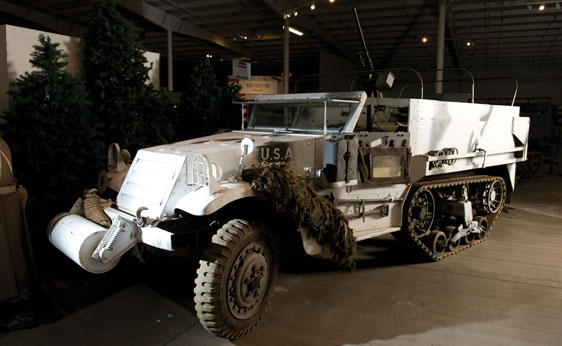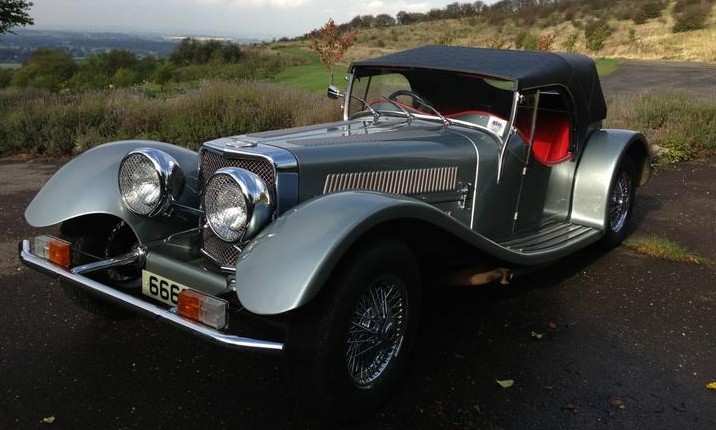Half-Tracked Vehicles from The National Military History Center
All offered by Auctions America | Auburn, Indiana | December 8, 2012
1943 Ford Maultier

This Ford “Maultier” (or “Mule”) is one of quite a few half-tracks going under the hammer from the National Military History Center in Auburn, Indiana. I’m not sure of the story behind this sale. The collection is quite astounding and it’s a shame that it’s being broken up and sold off, especially considering they are all available for the public to see. Half-tracks are some of my favorite WWII vehicles because… well they’re just so awesome. I’m unaware of the condition of these vehicles. The paint looks fresh but they are museum pieces so they might not be in the best shape mechanically (some even lack engines). But who cares – they are all rare and all really, really cool.
This one was built by Ford of Germany (this collection includes an impressive number of rare “Axis” vehicles). It’s powered by a 3.9-liter V8 making 95 horsepower. It will do 25 mph with those big tracks on the back. More here.
Update: Sold $42,500.
1945 Daimler-Benz DB10 Sd.Kfz. 8

Daimler-Benz was the name of the company that owned Mercedes-Benz in the 1930s. Instead of badging their Sd.Kfz.8s as “Mercedes-Benz,” they went ahead and just called them “Daimler-Benz”es – as were most of their heavy machinery during the war. The front is adorned with the three-pointed Mercedes-Benz star, but lacks the ring around it.
These were in production from 1937 until 1945 and used a Maybach 8.5-liter V12 making 185 horsepower, although this particular truck is engine-less. It has a 12-ton payload capacity – in other words, it’s a monster. About 4,000 were built in total by various manufacturers making this one of the most desirable half-tracks you can get. More here.
Update: Sold $200,000.
1941 Autocar M3

This is, by far, one of my favorites of this sale. It has that classic look – as did most of the vehicles produced by White, Autocar and Diamond T. That slanted front where a radiator would usually be. And whatever that thing is hanging off the front. Classic.
About 12,000 of these were built for the U.S. war effort (about 41,000 half-tracks were built in total of all kinds for the U.S.). This one has a 148 horsepower 6.3-liter straight-six. It’s quick too, capable of 40 mph. More here.
Update: Sold $38,000.
1940 Hanomag S.P.W. Ausf. C Sd.Kfz. 251/1

This massive Hanomag is technically a 3/4-track. Whatever. I don’t like fractions. The Sd.KFz. 251 was one of the more popular German vehicles with 15,252 built by various manufacturers, with Hanomag being the most prolific. It uses a 100 horsepower 4.2-liter Maybach straight-six. This is a Model C (they made them in A through D configuration) so it had many improvements over earlier models, such as better engine ventilation. More here.
Update: Sold $160,000.
1944 Auto Union HL kl 6p

This Auto Union model was the final evolution of the 3-ton half-track. They were made for a short time in 1944 only and, due to material shortages in Germany at the time, the cabs were mostly finished with wood and/or cardboard. Classy. It’s powered by a 100 horsepower 4.2-liter Maybach straight-six. More here.
Update: Sold $75,000.
1943 Opel Maultier

This 2-ton Opel Maultier is one of about 4,000 built. It has a 75 horsepower 3.6-liter straight-eight. Opel was a curious case during the war. They have been a General Motors subsidy since 1929. When the war broke out, Opel’s automobile production ceased so they could help with the war effort. Meanwhile, back in Detroit, GM was building airplanes that could have possibly flown missions in Europe, essentially bombing their own factories. More here.
Update: Sold $65,000.
1939 Unic Kegresse P107/U304(f)

Unic, the French automobile manufacturer that turned to trucks in 1938 – which was highly convenient when war broke out the following year. Military vehicles are usually an extension of the heavy-truck business. Unic was bought by Fiat in 1966 and was merged into Iveco in 1975.
This Kegresse tracked tractor uses a 60 horsepower 3.4-liter straight-four. Kegresse means that the tracks are made out of rubber or canvas and not metal like most tanks and other half-tracks. I guess it’s gentler on the roads… or enemy soldiers. Strangely, all of these vehicles were built before the Germans took over France – but Germany used them anyway. More here.
Update: Sold $20,000.
1942 Borgward H kl 6

Carl Borgward’s little (okay, it wasn’t that little) automobile company was drafted into producing vehicles for the Reich. This truck has a 3-ton payload capacity and entered production in 1937. This particular vehicle does not have an engine – it’s more of a static display piece – but back during the war it likely had a 100 horsepower 4.2-liter Maybach straight-six. More here.
Update: Sold $145,000.
1944 White M16

Here’s another good-lookin’ White half-track, this one an M16. The M16 was essentially an M3 (like the Autocar above) but it has a powered, armored turret with up to four .50 caliber machine guns. As with all of the items offered in this sale, the guns have been demilitarized – meaning, they no longer work as guns. But this is what makes something like this legal to own… and drive down the street. Engine-wise, this is powered by a 148 horsepower 6.3-liter straight-six. More here.
Update: Sold $95,000.
1943 Opel Maultier Panzer-Werfer 42 Rocket Launcher

This Opel Panzer-Werfer is a tracked rocket launcher. It’s pretty mean looking, isn’t it? It has one 10-barreled rocket launcher mounted in the back – of course it no longer works, so you won’t be able to blast traffic jams out of your way. This piggish brute is powered by a 75 horsepower 3.6-liter eight-cylinder engine. It weighs about 7-tons, so that is probably no where near enough horsepower. Only 300 of these were built. More here and the rest of the auction lineup here.
Update: Sold $60,000.






